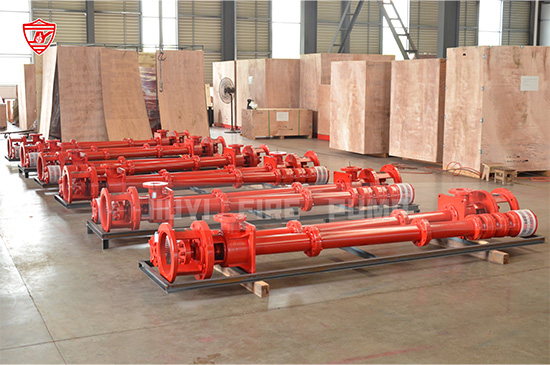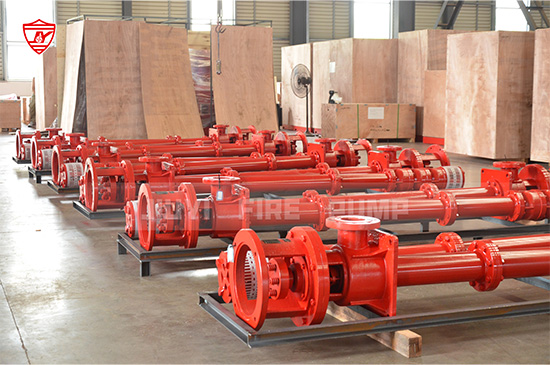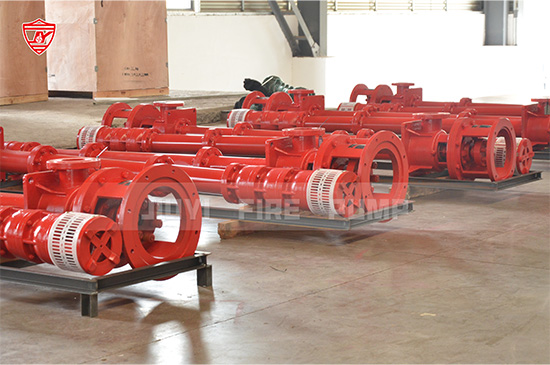Vertical pumps, especially vertical turbine fire pumps, are widely used in fire protection systems for high-rise buildings, industrial plants, and municipal water supply. As a manufacturer of fire pumps, we know that lifting and installing vertical pumps safely is one of the most critical steps during setup.
Improper lifting techniques can cause equipment damage, misalignment, or even serious injuries. In this article, we’ll walk you through the complete process of lifting a vertical pump safely and effectively, including preparation, rigging, handling, and installation best practices.

Vertical turbine pumps are tall, heavy, and precisely engineered machines, making them different from horizontal pumps. Here are the main challenges:
Height and weight – Vertical pumps are tall and heavy, requiring specialized rigging tools.
Fragile components – Shafts, columns, and bowls must not be bent or stressed.
Precision alignment – Incorrect lifting can cause shaft misalignment, leading to operational failures.
Safety risks – Mishandling can cause serious accidents, especially when lifting from elevated positions.
To avoid these issues, following proper lifting procedures is essential.
Before beginning any lifting operation, follow these safety guidelines:
Check for cracks, dents, or bent components.
Ensure the pump is free from residual packing materials.
Verify that all fragile parts are secured.
Use certified slings, spreader bars, and shackles.
Confirm the lifting capacity of cranes or hoists exceeds the pump’s total weight.
Always use lifting lugs provided by the manufacturer.
Only certified riggers should handle lifting.
Designate one supervisor to coordinate all movements.
Ensure all personnel wear helmets, gloves, and steel-toe boots.
Remove unnecessary tools and obstacles.
Mark a restricted safety zone around the lifting area.
To lift a vertical pump safely, you’ll need:
Overhead crane or mobile crane (capacity > pump weight)
Certified lifting slings or chains
Spreader bars to balance weight
Shackles and lifting hooks
Pump manufacturer’s installation guide
Torque wrenches for alignment adjustments
Vibration pads (if required)
Remove protective packaging carefully.
Check the shaft for proper lubrication.
Secure all rotating components to prevent accidental movement.
Use manufacturer-recommended lifting lugs.
Never attach slings to the pump shaft, coupling, or discharge head.
If no lifting points are visible, refer to the installation manual.
Use spreader bars to maintain balance and prevent side pressure.
Ensure slings are equally tensioned before starting the lift.
Double-check all shackle pins and locking mechanisms.
Raise the pump gradually to avoid sudden movements.
Stop after lifting a few inches to check sling stability.
Maintain vertical alignment to prevent twisting.
Use tag lines to control swinging.
Lower the pump carefully until the pump bowl assembly is aligned with the sump or column pipe.
Ensure the suction bell and column pipe remain straight.
Gently lower the pump until it rests on the foundation or mounting plate.
Check for level alignment using precision tools.
Tighten all foundation bolts according to the manufacturer’s specifications.

Fire pumps require extra care during installation since they are designed for critical safety systems:
Keep the pump shaft straight – A bent shaft will lead to vibration issues and reduced pump life.
Avoid side loads – Do not allow lateral forces during lifting.
Protect mechanical seals – Cover them to prevent dust or accidental damage.
Check for pipe strain – Ensure suction and discharge piping are properly aligned.
Even experienced installers sometimes make errors that can damage a vertical pump:
Using the wrong lifting points
Ignoring spreader bars and applying side pressure
Over-tightening bolts before alignment checks
Forgetting to lubricate shaft bearings
Allowing pipes to impose stress on the pump body
Avoiding these mistakes can save time, money, and equipment.
Once the pump is installed:
Check that the pump is level and plumb.
Rotate the shaft by hand to confirm smooth movement.
Verify coupling alignment with precision instruments.
Inspect electrical and control connections.
Conduct a test run to ensure optimal performance.
For fire protection systems, reliability is non-negotiable. Improper lifting can lead to:
Shaft misalignment and excessive vibration
Reduced efficiency and higher energy costs
Premature bearing and seal failure
Unexpected downtime during fire emergencies
By following the proper lifting techniques, you ensure long-term pump performance and safety compliance.

Lifting a vertical pump, especially a vertical turbine fire pump, requires careful planning, the right tools, and strict adherence to safety procedures. By following the steps outlined above, you can:
Prevent damage to pump components
Reduce installation risks
Ensure precise alignment
Maximize pump efficiency and lifespan
As a leading fire pump manufacturer, we always recommend using trained professionals and following manufacturer guidelines during installation.